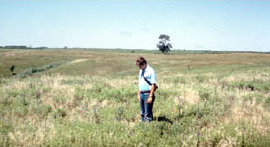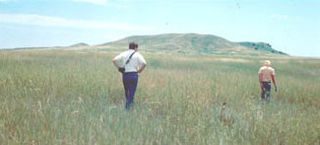
The Crow Creek massacre occurred around the mid-14th century AD and involved Native American groups at a site along the upper Missouri River in the South Dakota area; it is now within the Crow Creek Indian Reservation. Crow Creek Site, the site of the massacre near Chamberlain, is an archaeological site and a U.S. National Historic Landmark, located at coordinates 43°58′48″N 99°19′54″W. An excavation of part of the site was done in the 1950s, at the time of dam construction on the river. Additional excavations were conducted in 1978 and later.

Lake Oahe is a large reservoir behind Oahe Dam on the Missouri River; it begins in central South Dakota and continues north into North Dakota in the United States. The lake has an area of 370,000 acres (1,500 km2) and a maximum depth of 205 ft (62 m). By volume, it is the fourth-largest reservoir in the US. Lake Oahe has a length of approximately 231 mi (372 km) and has a shoreline of 2,250 mi (3,620 km). 51 recreation areas are located along Lake Oahe, and 1.5 million people visit the reservoir every year. The lake is named for the 1874 Oahe Indian Mission.

There are 459 properties and historic districts listed on the National Register of Historic Places in North Dakota. There are listings in 52 of North Dakota's 53 counties.
The Phipps Site (13CK21) is a Late Prehistoric Mill Creek culture archaeological site near Cherokee in Cherokee County, Iowa, United States. Its principal feature, a refuse midden, has yielded important information on the formation of middens in the region. The site was declared a National Historic Landmark in 1964.

The Hagen Site, also designated by the Smithsonian trinomial 24DW1, is an archaeological site near Glendive in Dawson County, Montana. The site, excavated in the 1930s, is theorized to represent a rare instance of a settlement from early in the period in which the Crow and Hidatsa Native American tribes separated from one another. It was declared a National Historic Landmark in 1964.
The McLemore Site, designated by the Smithsonian trinomial 34WA5, is a prehistoric archaeological site of the Southern Plains villagers located near Colony in Washita County, Oklahoma. It is the site of a prehistoric Plains Indian village, dating from AD 1330-1360, during the Washita River phase. The site is of historic importance for being a key element helping determine the chronology of prehistoric cultures in the region. It was declared a National Historic Landmark in 1964.

The Palmer Site, also known as the Skidi Pawnee Village and designated by the Smithsonian trinomial 25HW1, is a prehistoric and historic archeological site near Palmer, Nebraska in Howard and Merrick Counties. The site is a Native American habitation site associated with the Skidi people, a branch of the Pawnee people, which may have been documented by an American exploratory expedition led by Stephen H. Long in 1820. It was declared a National Historic Landmark in 1964. The site is located on private property.
The Schultz site, also known as Mira Creek site, and designated by archaeologists with the Smithsonian trinomial 25 VY 1, is a major prehistoric archaeological site near North Loup, Nebraska. It is the largest Middle Woodland period site in the state, covering 30,000 square feet (2,800 m2), with layers suggestive of repeated occupation. It is one of the oldest sites in the state exhibiting evidence of pottery manufacture. It was declared a National Historic Landmark in 1964.

Leary Site, also known as 25-RH-1 or Leary-Kelly Site is an archaeological site near Rulo, Nebraska and the Big Nemaha River. The site now lies entirely on the reservation of the Iowa Tribe of Kansas and Nebraska. The area was once a village and burial site.
The Walker Gilmore site, designated by the Smithsonian trinomial 22CC28, is a prehistoric archaeological site near Murray, Nebraska. First formally investigated in 1915, it is the type site for the Sterns Creek focus, the first Woodland period culture identified in Nebraska. It was designated a National Historic Landmark in 1964.

The Arzberger site, designated by archaeologists with the Smithsonian trinomial 39HU6, is a major archaeological site in Hughes County, near Pierre, South Dakota. It was declared a National Historic Landmark in 1964. It is a large fortified village, that is the type site for the Initial Coalescent, a culture that flourished in the area c. 1200-1350 CE.
The Vanderbilt Archeological Site is an archaeological site located on the shore of Lake Oahe in Campbell County, South Dakota, near Pollock, South Dakota. The site contains the remains of a Native American Plains village which has been tentatively dated to about 1300 AD. Despite the fact that the site is subject to erosive destruction from wave action on the lake, it has been determined likely to yield significant information about the movements and living patterns of prehistoric Native Americans in the region. The site was declared a National Historic Landmark in 1997.

The Bloom Site, designated by the Smithsonian trinomial 39HS1, is an archaeological site in Hanson County, South Dakota. It was declared a National Historic Landmark in 1964.

The Langdeau Site, designated by the Smithsonian trinomial 39LM209, is an archaeological site in Lyman County, South Dakota, near Lower Brule. It was declared a National Historic Landmark in 1964. The site was one of the first to provide evidence of horticultural activity by Native Americans in the region.

The Mitchell Site, designated by the Smithsonian trinomial 39DV2, is an important archaeological site in Mitchell, Davison County, South Dakota. It was declared a National Historic Landmark in 1964. At that time it was the only reliably dated site of the Lower James River Phase. The site, sheltered under a dome, is managed by a nonprofit organization and is open to the public as Mitchell Prehistoric Indian Village. Visitors can watch archaeologists uncover artifacts in the Thomsen Center Archeodome. The Boehnen Memorial Museum features a reconstructed lodge and many of the artifacts found at the site.

The Fort Thompson Mounds are a complex of ancient archaeological sites in Buffalo County, South Dakota, near Fort Thompson and within the Crow Creek Reservation. Declared a National Historic Landmark in 1964 by the US Department of Interior, the mound complex extends for a distance of about 6 miles (9.7 km) along the east bank of the Missouri River. It is one of the largest known complex of burial mounds in the Plains region north of Kansas.

The Osage Village State Historic Site is a publicly owned property in Vernon County, Missouri, maintained by the Missouri Department of Natural Resources. The historic site preserves the archaeological site of a major Osage village, that once had some 200 lodges housing 2,000 to 3,000 people. The site, designated by the Smithsonian trinomial 23VE01, was also known for many years as the Carrington Osage Village Site, under which name it was designated a National Historic Landmark in 1964.

This is a list of the National Register of Historic Places listings in Dewey County, South Dakota.
The Biesterfeldt Site is an archaeological site near Lisbon, North Dakota, United States, located along the Sheyenne River. The site is the only documented village of earth lodges in the watershed of the Red River, and the only one that has been unambiguously affiliated with the Cheyenne tribe. An independent group of Cheyennes is believed to have occupied it c. 1724–1780. In 1980, the site was listed on the National Register of Historic Places because of its archaeological significance. It was designated a National Historic Landmark in 2016.
















